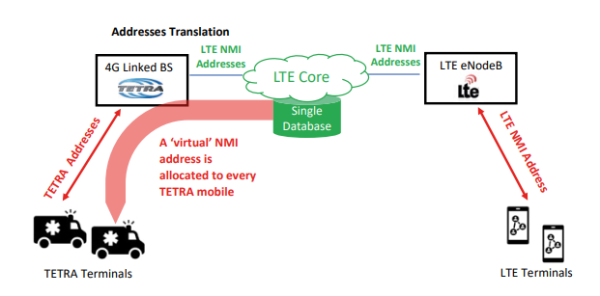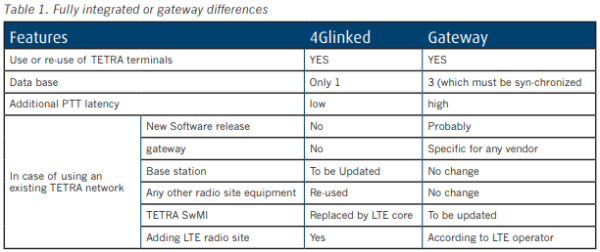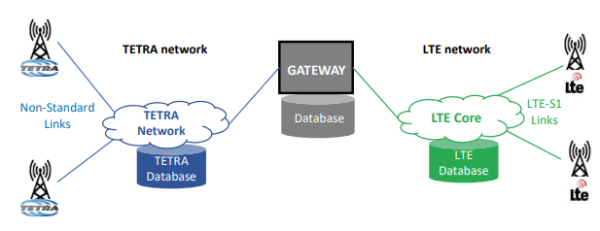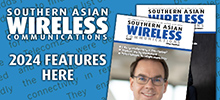07 April 2022
From its Headquarters in Paris, ETELM has been supplying critical communications infrastructure for over 40 years to systems integration and partners worldwide. In response to the demand for mission critical broadband services ETELM has developed one of the most advanced, fully integrated hybrid solutions – 4G Linked; combining both LTE and TETRA Base Stations on a single core network. The system utilises all the benefits of the standard LTE Core as the management system for both TETRA and 4G Subscribers, thereby avoiding separate networks and gateways. Indeed the TETRA Base Station connects directly to the LTE Core in the same way as any eNodeB.

Figure 1: 4G Linked Basic Architecture
ETELM strongly believes that the future of all private critical mobile communications should be based on 3GPP’s internationally recognised core networking standards – 4G LTE Core and 5G NR standards are the most powerful mobile communications architectures available, and we believe should be adopted by all types of communications technologies. This will allow critical communications users to leverage from advances in the high-volume consumer marketplace and if adopted by other vendors, will allow true interoperability to exist between all manufacturers and across different technologies. This concept would potentially allow users to mix TETRA, LTE and other communications technologies over the same standardised core network…
4G LINKED ARCHITECTURE
ETELM’s 4G Linked is an advanced hybrid solution for mission critical users, combining the benefits of both TETRA and LTE in a single network, based on internationally standardised networking. The system architecture is very straight forward and avoids complex gateways and interfaces. The transmission eco-system utilising the LTE Core with all central management servers connected to radio sites equipped with4G Linked TETRA Base Stations which are directly connected in the same way as any LTE Base Stations (eNodeB’s). This is achieved as we have added the LTE standard S1 connectivity to the 4G Linked TETRA base station, so in effect it becomes a ‘TETRA eNodeB’.
Cell sites may be designed with TETRA only, LTE only or merged TETRA and LTE equipment – all connected to the same core, this is entirely based on the services and geographic coverage required by the user. Communications between TETRA and LTE subscribers is completely seamless to the user, and call set-up time significantly faster than any separate networks with gateway solutions, particularly where group calls are concerned. The architecture comprises five essential building blocks:
1. Central Equipment: Based on the 3GPP standard IP based LTE core (including MME, PDN and a central data base ) and a standard IMSI server for audio communication; MCPTT Server may be added optionally where group functions are required.
2. TETRA radio site equipment: Each TETRA Site has one or more 4G Linked Base Station along with standard site equipment (antennas, feeders, power supplies etc.)– if the system is updating existing TETRA radio sites, all existing RF/PSU equipment can be re-used (duplexers, filters, antennas).
3. LTE radio site equipment: Any standard 4G LTE eNodeB radio base stations, with antennas, feeders etc. ETELM supplies its own range of LTE eNodeB’s but, as with any LTE network, the core supports standard eNodeB’s from any vendor.

Figure 2: 4G Linked Protocols
4. TETRA terminals: All Standard TETRA Terminals are supported – a major advantage being that all existing TETRA subscribers can be re-used or re-deployed, ensuring that users can retain and redeploy their investment
5. LTE terminals: Again using standard LTE Smartphones configured according to the services and frequency band allocated. Note: Dual Band TETRA + LTE Terminals are now available which can be used where users wish to use both TETRA and LTE Services.
HOW 4G LINKED WORKS
Standard smartphones under LTE coverage operate in exactly the same as in any public 4G network, with identical functionality. Audio functions are managed by the IMSI server for selective calls and using an MCPTT server for group calls (most MCPTT servers include the IMSI server)

Figure 3: 4G Linked Addressing
Standard TETRA terminals under the PMR coverage area operate with full TETRA standard functionality They register on a TETRA 4G Linked base station. This base station seamlessly converts the registration request into an LTE registration request on the network and continues converting any request and response (from infrastructure or from mobile.)
Due to this automatic subscriber database conversion the TETRA terminals appear from the Core’s perspective just like any other LTE smartphone. The system thereby allows seamless communications between smartphones and TETRA subscribers.

This conversion is possible using a special numbering scheme: each TETRA terminal is mapped at the network administration level with an LTE standard NMI number which is uniquely allocated to this mobile-just like any smartphone. The standard TETRA address is used over the air, but translated to a ‘virtual’ NMI address by the base station. As a result of this seamless conversion, the core equipment only manages NMI addresses and the TETRA user (theoretically) does not need to be made aware of its related NMI address.
Obviously, in the central database, an NMI address range must be retained for TETRA terminals. This range is preserved for profile number use as the first numbers in the NMI plan. This is just an example, it also may be configure in a different way.
The 4G Linked base station must be aware of the address conversion rules – this issue is mainly simplified by using ‘profile’ that is, the base station converts the TETRA address into the profile head-number and the TETRA address (last numbers of ITSI).
FEATURES
All selective audio functions are retained between TETRA terminals. All audio selective functions are provided between TETRA and LTE terminals
Group audio functionality between mixed user groups (groups comprising a mix of TETRA and LTE subscribers) are provided when there is an MCPTT server and when smartphones are loaded with an MCPTT application.
All these functions apply to TETRA terminals under TETRA coverage areas and LTE terminals under LTE coverage areas.
Any service and/or function requiring high data rates (LTE Services) are not supported by TETRA terminals.

Figure 4: The Gateway Alternative
GATEWAY/4G LINKED COMPARISON
An alternative to the fully integrated 4G Linked approach for TETRA/LTE interconnection is to add a Gateway between the TETRA SwMI and the LTE network. This means that the TETRA and LTE cell sites are connected on their own independent networks, with the gateway acting as a bridge.
The Gateway must comprise of two elements – the LTE Interface and the TETRA interface. The interface to the LTE Core may be fully standardised, however connection to any TETRA network is proprietary to each vendor – as a result, all gateways must have a proprietary element in order to operate.
The two different approaches have advantages and disadvantages (see table above).
Two main problems exist with gateways:
PTT latency
The PTT management requires a network wide solution, this is quite straightforward for individual calls but extremely complex for group calls. The system must ‘search’ for the terminals included in the group call and assess call priorities extremely quickly. The first step is the choice of terminal to be granted permission in case of several parties requesting the token ring (priority, age of the requests….). Where the system is fully integrated the group set-up is managed extremely quickly, however for the gateway option, the TETRA network manages calls between TETRA terminals, and the LTE network between respective LTE terminals, however the gateway forms a ‘bottleneck’ and so there is some latency which is unacceptable for many PMR users.
Databases
LTE networks have their own standardised user database (HSS) and TETRA networks have their own proprietary database embedded inside the SwMI. The gateway must also have its own database, describing the rights for a terminal to join (or not) another terminal (or group) in another network. This means that there are 3 independent databases to manage for the whole system and these must be synchronized all the time – a nightmare for network managers! Conversely the 4G Linked solution only uses the standard HSS as a single, unique user database for all subscribers, this is possible since TETRA terminals are converted from a numbering perspective to the LTE standard numbering with their ‘virtual’ NMI mapped to it’s TETRA Subscriber Identity (ITSI).
COST IMPLICATIONS
The cost comparison is very different according to the existing infrastructure:
Case A : a TETRA network exists, but no LTE network
Case B : there is both a TETRA and LTE network
Case C : there is an LTE network and no TETRA network (this case is rare since, when a private LTE network is in operation there is no reason to deploy a TETRA network – but in the case of specific and/or economic situations).
Case D : there is neither TETRA network nor an LTE one (this case is also rare).
Cases A and B are the most common and should be looked at carefully:
• TETRA radio sites are not fundamentally changed: the existing antenna system, feeders/cabling, lightning protection, power supply units (in general 48V dc) RF coupling, duplexers, cavities etc. are fully retained and re-used. Only base stations (often in need of updating for first generation TETRA systems) are to be changed
Note: In the case of existing ETELM Networks - ETELM TETRA base station may be upgraded to 4G Linked by software upgrade only.
• Central Equipment: In case B, the links to the radio sites are simply routed to the LTE core (IP links)
In case A, an LTE core is added in place of the TETRA SwMI (with IMSI and/or MCPTT server) – there is no longer any need for a TETRA SwMI as all network management is performed by the distributed LTE Core.
In any case, the existing TETRA SwMI is no longer required as all functions are managed by the standard LTE Core for both TETRA and LTE Base Stations.
The cost for Case D is the same as for deploying a new LTE network, but with reduced radio site costs. All these costs relate to CAPEX investments, the operational costs (OPEX) are different according to whether the LTE network is a public one or owned by the same operator as the
TETRA network; in the first case, the OPEX is mainly included in the contract with the external operator, in the other case the added LTE radio sites OPEX is the same as for the existing TETRA sites (apart from the cost of frequencies)
It is to be noted that in case of radio sites with 4G linked BS and eNodeB’s, the IP links to the central equipment may be shared by using S1 multiplexors.
4GLINKED NETWORK MANAGMENT
The network management of the 4G Linked System may be decided by the system administrator either with separate LTE and TETRA management or with a unified management system.
The unified solution is based upon the LTE standard management rules with an OAM separating seven managements functions:
• Alarms management
• Configuration management
• Software management
• Security management
• User management (data base)
• Billing management
• Performance management
In the fully integrated approach, a unique view of the whole network is available, displaying TETRA and LTE equipment; according to the user selection, the function request is routed either to TETRA or to LTE equipment as necessary.
MODULARITY
The main advantage of the 4G Linked solution (in case A) is to move seamlessly from TETRA to LTE, allowing re-use of the TETRA terminal fleets and the majority of the infrastructure and the possibility to add LTE radio sites (to existing TETRA Sites and/or new LTE Cell Sites) to ensure LTE radio coverage in areas where smartphone functionality is required (and access to their APIs) with the benefit of being able to communicate with existing TETRA mobiles (or TETRA groups).
4G or 5G
As technology is evolving the 4G Linked approach is almost identical for 5G; the choice of which technology is selected is dependent on two main factors:
• Frequency bands: 5G is mainly defined for frequencies above 3.5 GHz, which does not offer the same coverage as with lower frequencies – especially with PMR; moreover, in many countries the 5G spectrum may not be available and/or very expensive.
• Costs: Currently 5G equipment is much more expensive than 4G and the functional difference is very limited (especially the latency.)
CONCLUSION
As the industry transitions from traditional narrowband PMR to mission critical broadband services, there are several scenarios where clients may need to benefit from a hybrid solution, these include but are not limited to:
1. Re-use of existing investment in user equipment i.e. TETRA terminals
2. Minimise risk of transition to new technology, important for critical comms
3. Overcome limitations in availability of spectrum for private 4G or 5G
4. Balance spectrum costs and service requirements for specific users
5. Prioritise 4G/5G services in small, concentrated areas with high density of users and PMR services in wider geographic areas with fewer users
There will be a high demand for merging technologies either for technology transition, cost or simply frequency availability, and although the gateway method may be an option for some users, the benefit of a fully integrated solution such as 4GLinked cannot be underestimated.
This is particularly so where a long-term solution is required, since an integrated approach avoids the added cost of separate networks and gateways which can be more costly and difficult to maintain and update long term. It goes without saying that fast call set-up is essential for critical communications, however gateways will have a significant impact on latency particularly when managing group calls between several users on different networks and technologies. 4GLinked is based on a single core network approach with TETRA mobiles viewed from the network perspective as ‘virtual’ LTE devices so the latency is significantly reduced. As the 4G Linked approach uses latest, internationally standardised core networking it can keep pace with all latest mobile communications standards, and avoids dependence on proprietary gateways and the associated security and maintenance issues.
Contact: Paul Ward, Sales Director, ETELM paul.ward@etelm.fr






